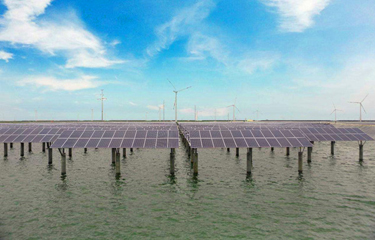China’s government folding tourism into aquaculture, energy policies for domestic growth

The future of Chinese aquaculture is on display this week in Jiangsu Province, where the feed and energy giant Tongwei Group is showcasing a new Jiangsu Provincial Level Premium Products Park.
The park incorporates several large fish ponds all partly covered with solar panels, which will collectively generate 50 megawatts (MW) of electricity. The ponds produce crabs, turtles, crayfish, and prawns, according to an invitation for the grand opening sent to SeafoodSource.
The park has three goals: the third – after solar energy and seafood production – is leisure. Hence the selfie sticks and the fancy restaurant in the park serving produce from the ponds to visitors at downtown city prices. So too the “popular science” building, which caters for school groups, a feeding station where visitors pay to feed the crustaceans, and viewing platforms where visitors can take photos against a backdrop of ponds and rows of giant photovoltaic solar panels.
A pioneer of combining solar arrays with aquaculture facilities, Tongwei is now betting that tourism will earn it more than either the electricity or the seafood produced in the park. The company has synched its development with government policy by replacing low-end aquaculture with higher-quality technology that also creates jobs for rural dwellers – local government money backed the Jiangsu Provincial Level Premium Products Park with funds for roads and utility connections.
The national government’s vision was spelled out in a 2019 Agriculture Ministry document, “Opinions on the Acceleration of Green Development of Aquaculture,” which promotes a water pollution fix and a related diversification of incomes for fish farmers and fishermen.
Speeding up the diversification process, a multi-agency “Census of Water Pollution” has become an annual feature of provincial government workloads as China trades reduced aquaculture volume for higher-quality water and seafood. The Agriculture Ministry’s current list of priorities promotes the use of low-cost recirculating water systems in shipping containers to reduce water pollution from intensive aquaculture.
Chinese aquaculture topped 50 million tons of production in 2019, but aquafeed firms Coland Holdings Co. and Cargill China are predicting that aquaculture production will be flat in coming years, as the country shifts from a focus on value species to premium, higher-value species like eel and croaker.
A further sign of where government money is going to support this new vision of Chinese seafood production was on show recently at the launch of Haikou Recreational Fishing Test Zone on the fringes of a flashy sailboat trade show held on the southern island of Hainan recently.
Government officials were on hand to describe how they’re building infrastructure for “leisure fishing” like piers and boat sheds, where decommissioned and repurposed fishing trawlers will ply their trade as fishing cruisers taking recreational anglers out for a day on the water.
“Rather than building ports for trawlers, we’ll speed up the building of more public docks,” Haikou Deputy Mayor Long Weidong said at the event, held in his city. He said the island also hopes to develop “clean energy” engines for some of its 32,000 trawlers, of which 19,000 are licensed by his office.
The financial potential of leisure fishing is also a draw for the country’s increasingly dominant state-owned corporations. Zhao Ying Jie, the deputy director of the Ministry of Agriculture’s provincial office on Hainan, said the provincial government will set up a state-run development company for the recreational fishing sector.
With its semi-tropical location in the South China Sea, Hainan is a big beach destination for Chinese travelers, but the local government has sought to encourage more business development through the designation of large free trade zones and duty-free shopping centres.
If China’s plans for a higher-value aquaculture sector work out, that could mean a reduced volume of product for export and more emphasis on domestic consumption – another broader, long-term government priority.
Meanwhile, this autumn, in support of the Chinese national plan for “green” aquaculture, government fishery offices across China are running what’s termed the “Five Actions” campaign: reducing water pollution from aquaculture; reducing antibiotics use; improving genetics and seedlings quality; increasing the use of compound feed; and reducing the use of juvenile fish as feed.
A “greener” aquaculture sector should also mean higher prices for product – at least that’s the vision, and one partly facilitated by the COVID-19 pandemic. At the recent Fuzhou Fisheries Expo, officials and seafood executives shared a platform with invited health specialists to devise a “health from seafood” strategy whereby sales are driven through COVID-prompted concerns.
Among those invited to speak at the event – organized by the China Fisheries Association, a state sponsored industry lobby – were Dr. Wang Xingguo, director of the nutrition department at Dalian Central Hospital; Dr. Peng Tao from Peking University Hospital, the elite medical institution in Beijing; and Dr. Gao Chao from the Chinese Center for Disease Control and Prevention.
Photo courtesy of Tongwei Solar






Share